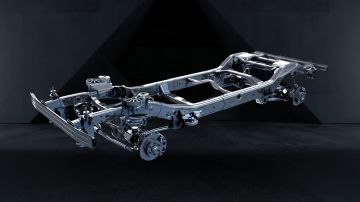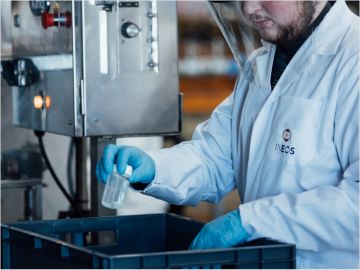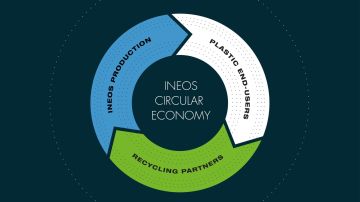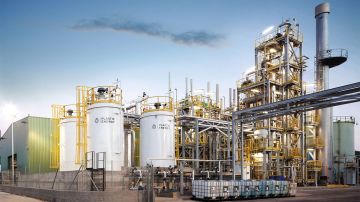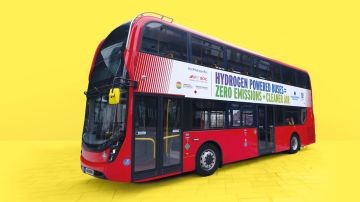INEOS used to look to the very best in the chemical industry for inspiration. Those companies helped it to focus on where it wanted - and needed - to be when it came to its safety record. Today, it looks to itself.
“We cannot look to others anymore because we are now right up there with the best,” said Simon Laker, INEOS Group Operations Director.
The OSHA figures show that INEOS last year recorded its best-ever performance, falling from 0.91 in 2009 to 0.16.
“We don’t like to say we are the world’s best, but we are world class,” said Simon.
Top of the class for INEOS was the Oil & Gas UK business which recorded zero.
What the figures don’t show is what it took for INEOS to achieve that level of excellence. Over the years it has developed numerous systems to address each problem as it has arisen.
There are few group-wide systems in INEOS, but safety is one of them. All sites are regularly audited against the 20 Principles, which cover everything from how to control work to how to control change.
Staff, seeking solutions, can find the best performing sites and hence the answers easily. “That really is the power of INEOS,” said Simon.
There is a bonus structure that is inextricably linked to a site’s safety performance, including how tidy it is and how well maintained. “The gate to the bonus won’t open if the site’s housekeeping is not in order,” said Simon.
That changed after INEOS introduced the AsCare audit system following a poor standard of housekeeping and maintenance on one of its French assets.
“Today if you go on to any site, you can tell which parts are owned by INEOS because they are spotless,” he said.
There are few group-wide systems in INEOS, but safety is one of them. All sites are regularly audited against the 20 Principles, which cover everything from how to control work to how to control change.
Sites that perform badly – in terms of such things as injuries, leaks and environmental breaches – are placed on a RED list. “We deem a RED list site as having an unacceptable risk for INEOS,” said Simon. Each RED site is given two years to fix the problems. If it cannot be brought up to the required standard, the site is shut down and closed.
“We don’t want to close sites but we just cannot run a site that can potentially hurt people,” said Simon. “It could lead to a catastrophe and that’s abhorrent. It is those sort of things that really do keep us awake at night.”
In 2012 INEOS introduced 20 basic safety principles covering processes and staff’s behaviour.
Those messages have helped to drive down reportable incidents and produce INEOS’ best-ever safety performance.
But not everyone always follows them.
“Every time there is an incident, it is reviewed to see if any one of the 20 principles has been broken,” he said.
“I have yet to find one incident where that’s not happened. If we always followed those principles, we would never have another incident in INEOS.”
Huge improvements have been made over the years, as can be seen by the safety performance, but there are a few critical activities that are so important that any breach will result in instant dismissal. These are the life-saving rules.
“Other companies may give them more chances, but why would we allow people a second chance to kill themselves or one of their colleagues?” said Simon. “We cannot have people like that in our organisation.”
INEOS has achieved its best-ever OSHA performance, despite acquiring more businesses whose procedures and rules on safety and standards often differ.
“We do assess the risk when we are looking to buy new companies,” said Simon. “Most have a worse safety performance than us. The first priority when they join us is to get their safety levels to where INEOS’ are.”
But that mixed heritage – and there are people working in INEOS who have come from BP, BASF, ICI and many others – does bring certain advantages.
“Others may see it as a weakness,” said Simon. “But we see it that somewhere amongst all these heritages is the answer to any problem.”
Each month INEOS Chairman Sir Jim Ratcliffe is given a detailed report, showing the number of such things as safety critical alarms or overdue inspections.
It has been known for some sites, acquired by INEOS, to report hundreds of such alarms and missed inspections in just a month. “Within one or two years they are back to what we expect in INEOS,” said Simon.
For INEOS, though, the work never stops. “When a business’ performance improves, we move the goalposts to encourage it to do even better,” he said. “It all comes back down to the fear of complacency. As soon as you think you’re there, you’re not.”
20 Principles
Behavioural Safety
01 - We believe all incidents and injuries can be prevented
02 - Everyone's first responsibility is to ensure they work safely
03 - Everyone has the duty to stop work if they feel the situation in unsafe
04 - The expectations and standards are the same for everyone on the site
05 - Rules and procedures must be observed and respected
06 - We should look out for each other’s safety and unsafe situations
07 - All injuries and incident / near misses must be reported and investigated
08 - Risk assessment must be carried out prior to, during and on completion of work
09 - All team leaders have a special responsibility for promoting and upholding these principles
10 - We must always work within the limit of our competency and training
Process Safety
01 - The asset operating manager is responsible for its overall integrity
02 - The asset engineers are responsible for maintaining the asset and protective systems integrity
03 - The responsibilities in the organisation for defining and maintaining the correct operating envelopes must be clear
04 - Operating procedures and envelopes must be observed. Deviations must be reported and investigated
05 - Any changes must be properly risk assessed and subjected to MOC procedures
06 - Process hazards are systematically identified, risk assesses, reviewed and managed
07 - All assets must be subject to periodic inspection designed to ensure their integrity and the reliability of their protective systems
08 - Operations must always place the safe operation or shutdown of the asset ahead of production
09 - When in doubt the asset must always be taken to its safest state
10 - We have emergency plans based on assessed risks which are regularly tested
